Dean of Engineering, Howard University
 Lee Julian Purnell is the first Black student known to have graduated from the EECS department. He was born into a prominent family of Black trailblazers and activists, including great-grandparents Absalom Shadd, John Jones, and Mary Jane Richardson Jones, and grandparents James Whipper Purnell and Hugh Mason Browne (by marriage). The Shadds and Purnells are collectively considered to be one of the dynastic pillars of Howard University.[1]
Lee Julian Purnell is the first Black student known to have graduated from the EECS department. He was born into a prominent family of Black trailblazers and activists, including great-grandparents Absalom Shadd, John Jones, and Mary Jane Richardson Jones, and grandparents James Whipper Purnell and Hugh Mason Browne (by marriage). The Shadds and Purnells are collectively considered to be one of the dynastic pillars of Howard University.[1]
 Lee’s mother, Theodora Lee (1871-1967), was an artist, writer, teacher,[2] and civic leader.[3] His father, William Whipper Purnell (1869-1935), was an ophthalmologist and otologist,[4] who worked as an assistant instructor at the Howard University Medical Center before volunteering to serve in the Spanish-American War.[5] He eventually rose to the position of Captain Assistant Surgeon of the 48th Volunteer Infantry.[6] William and Theodora married in 1895 and Lee was born a year later. William was mustered out of service in 1901, and the family moved to the Bay Area where William opened a medical office on Washington Street[7] in downtown Oakland. In 1919, he was “the only colored doctor” in the East Bay and had “a rapidly growing practice among Italians, Spanish,” and African-Americans. He was a member of the Oakland Chamber of Commerce and both parents were involved in a number of social clubs. [8]
Lee’s mother, Theodora Lee (1871-1967), was an artist, writer, teacher,[2] and civic leader.[3] His father, William Whipper Purnell (1869-1935), was an ophthalmologist and otologist,[4] who worked as an assistant instructor at the Howard University Medical Center before volunteering to serve in the Spanish-American War.[5] He eventually rose to the position of Captain Assistant Surgeon of the 48th Volunteer Infantry.[6] William and Theodora married in 1895 and Lee was born a year later. William was mustered out of service in 1901, and the family moved to the Bay Area where William opened a medical office on Washington Street[7] in downtown Oakland. In 1919, he was “the only colored doctor” in the East Bay and had “a rapidly growing practice among Italians, Spanish,” and African-Americans. He was a member of the Oakland Chamber of Commerce and both parents were involved in a number of social clubs. [8]
The Purnell family lived on the corner of Woolsey and California Streets in Berkeley.[9] Lee was a talented athlete and brilliant high school student. He made the pages of the Oakland Tribune for being one of the fastest sprinters in the Bay Area in the 100 yard dash,[10] and was awarded a gold medal for winning first place in the Berkeley High School Decathlon all around track meet. Lee’s goal was always to become an engineer. Starting in his freshman year of high school, he maintained a course of study which “specialized in mathematics and the other studies required to enter the college of engineering at the University of California…regarded as the most difficult in the high school curriculum.” He also took a class in mechanical drawing at the Berkeley School of Arts and Crafts, where his plate on V-shaped and square-screw threads was included in an exhibition.[11]
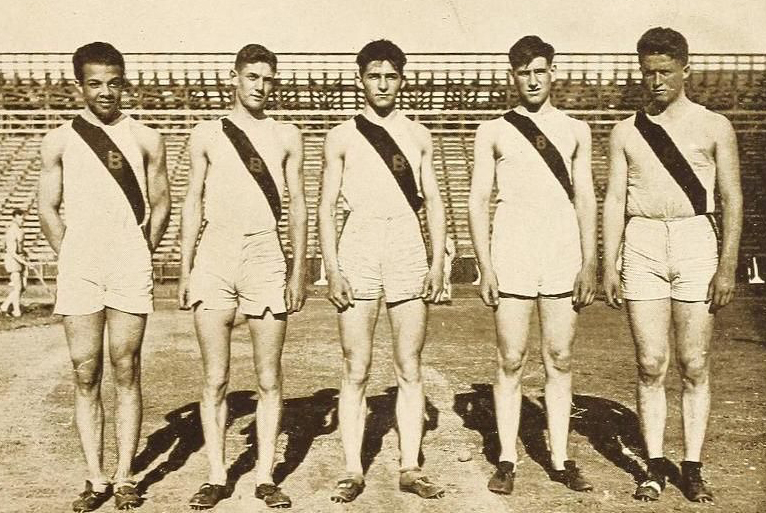
Lee graduated from Berkeley High in 1915, “the only member of the race” in that year’s graduating class of 186 students.”[12] He is listed in his high school yearbook as a member of the Spanish Club, Engineering Club, Gas Engine Club, Electrical Club, Baseball Team, and Track Team.[13] He also played football.[14]
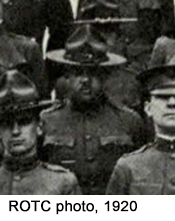 Lee enrolled in Cal in 1915. With the first World War as a backdrop to his college years, Lee followed his father’s military example and joined the ROTC, becoming Captain of Company C. [15] He led students in tactical drills twice a week in the Presidio, including two white cadet officers: First Lieutenant Albert Joshua Rumbold Houston and Second Lieutenant Adolph Louis Friedenthal.[16] This was probably a very unusual arrangement since the military was still strongly segregated during WWI, and Black officers would not be permitted to command white troops for another 40 years.[17] Purnell expressed interest in joining an officers’ training school if one opened on campus.[18]
Lee enrolled in Cal in 1915. With the first World War as a backdrop to his college years, Lee followed his father’s military example and joined the ROTC, becoming Captain of Company C. [15] He led students in tactical drills twice a week in the Presidio, including two white cadet officers: First Lieutenant Albert Joshua Rumbold Houston and Second Lieutenant Adolph Louis Friedenthal.[16] This was probably a very unusual arrangement since the military was still strongly segregated during WWI, and Black officers would not be permitted to command white troops for another 40 years.[17] Purnell expressed interest in joining an officers’ training school if one opened on campus.[18]
Lee continued to shine as an athlete, and was a member of the Big “C” in track.[19] At the 1917 Stanford vs. California track meet, “Purnell furnished a thrill in the 220-yard dash when he crossed the finish a fraction of an inch ahead of Lachmund of Stanford.” In the California vs. Southern California All-Stars varsity competition, he won the 200-yard dash in 23 seconds flat and came second in the 100-yard dash.
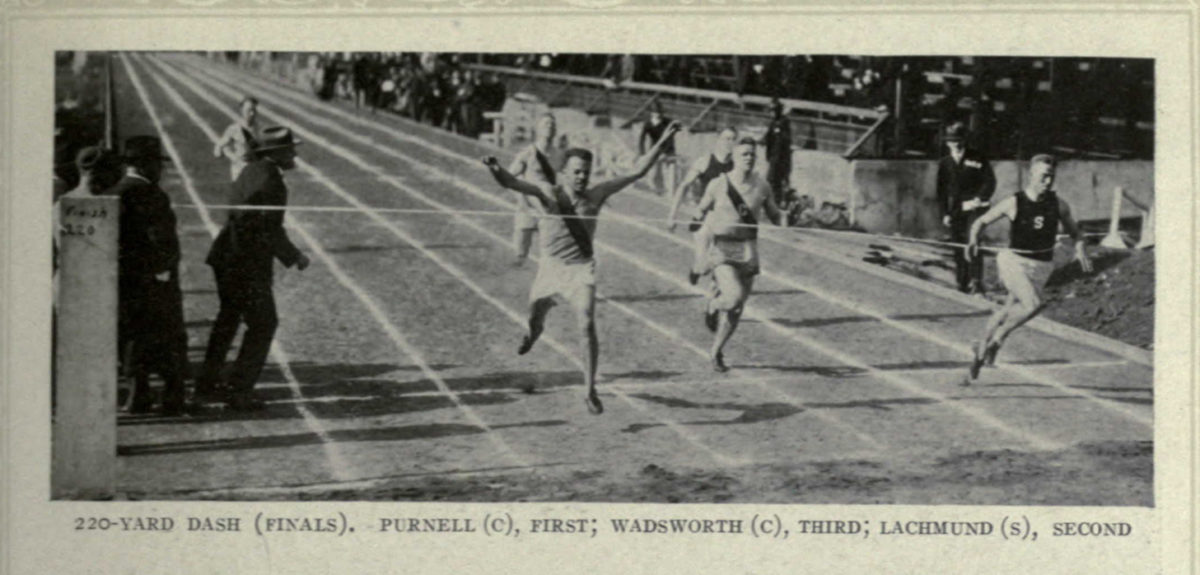
Although he initially enrolled in the College of Mechanics,[20] Lee graduated with an B.A. from the College of Letters and Science in 1919,[21] during UC’s 56th commencement. His major, and the reason he changed his degree, are unknown.[22]
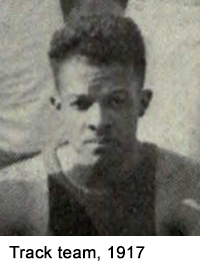 With his B.A. from Cal, Lee entered the Massachusetts Institute of Technology (MIT) as a junior. While at MIT, he was a member of the Aero Society, the California Club, and the fraternity Omega Psi Phi.[23] He earned a B.S. in Electrical Engineering in 1921 with a thesis titled “Unification of the Electric Power at the Fore River Shipyard.”[24] He and Civil Engineering student Emmett Jay Scott, Jr. were said to be the first two African American students to graduate from MIT in the same class.[25]
With his B.A. from Cal, Lee entered the Massachusetts Institute of Technology (MIT) as a junior. While at MIT, he was a member of the Aero Society, the California Club, and the fraternity Omega Psi Phi.[23] He earned a B.S. in Electrical Engineering in 1921 with a thesis titled “Unification of the Electric Power at the Fore River Shipyard.”[24] He and Civil Engineering student Emmett Jay Scott, Jr. were said to be the first two African American students to graduate from MIT in the same class.[25]
Lee returned to Berkeley and started a business, the Purnell Electric Company, with Charles F. Porter. His office was located on Market Street but he and Charles lived in the Purnell family home on Woolsey. [26] Lee eventually returned to Cal and earned an M.S. in EE in 1929. His thesis was titled “Electric substation design.”[27]
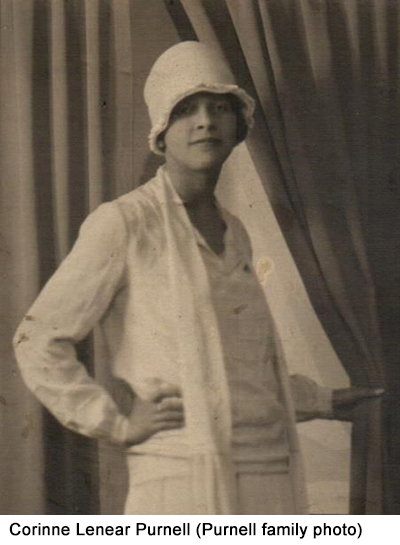 That year, he married socialite Corinne Ruth Lenear,[28] the daughter of an Oakland podiatrist.[28A] The couple first moved into the Purnell family home in Berkeley, and then Corinne’s parents’ home in Oakland.[29] Lee took a job as an electrical engineer at Pacific Gas & Electric,[30] and Corinne and Lee had a daughter one year later, Joyce Lee (Adams). Corinne died tragically, just three years later, at age 24.
That year, he married socialite Corinne Ruth Lenear,[28] the daughter of an Oakland podiatrist.[28A] The couple first moved into the Purnell family home in Berkeley, and then Corinne’s parents’ home in Oakland.[29] Lee took a job as an electrical engineer at Pacific Gas & Electric,[30] and Corinne and Lee had a daughter one year later, Joyce Lee (Adams). Corinne died tragically, just three years later, at age 24.
Although job opportunities for African Americans had never been very plentiful in the 1920s, they became even scarcer after the onset of the Great Depression. Shortly after Corinne’s death in 1933, Lee left the Bay Area to take a teaching post at Wilberforce University, an African American liberal arts college in Ohio. By 1935, he was teaching at Alcorn State University in Mississippi,[31] the nation’s first public historically Black land-grant institution.[32] Lee’s father died in 1935, and he returned to the Bay Area and took a position as the Education Director for the “Wheeler CCC camp,” a branch of the Civilian Conservation Corps[33] (CCC) in San Francisco. The CCC was a popular and successful New Deal Depression recovery program that put some two million unemployed men to work on a massive building program in Americas’ parks and forests.[34] The law that established the CCC stated that “no discrimination shall be made on account of race, color, or creed,” but by the time Lee joined, all of the camps were racially segregated, and few African Americans were permitted to hold leadership positions other than education advisor.[34A] All participants in the CCC were paid monthly, and provided with food, housing, clothing, and medical care, so positions were highly prized and, a result, local governments maneuvered to keep African Americans from enrolling. Only 10% of CCC participants were Black. However 87% of Black participants enrolled in the education program,[34B] and gained access to resources they would not otherwise have had, like learning to read and write, building typing skills, earning high school diplomas, and improving useful skills like wood carving.[34C]
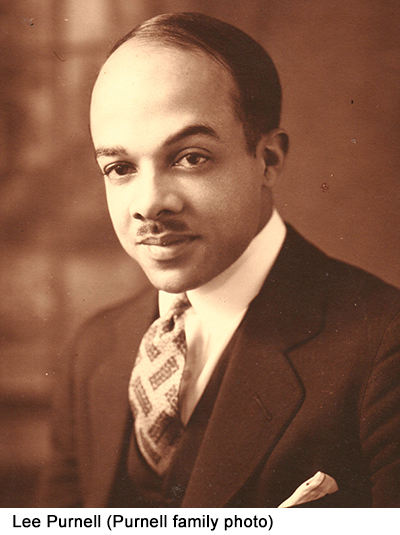 In 1938, Lee married for a second time to Mary Madeline Gillespie,[35] the Canadian-born granddaughter of civil rights activist Ezekiel Gillespie.[36] They lived with Theodora in the Purnell family home in Berkeley and had two children: a son, Lee Julian Jr., and daughter, Katherine May (Johnson). By 1940, Lee was between jobs as an “educator in public schools.”[37]
In 1938, Lee married for a second time to Mary Madeline Gillespie,[35] the Canadian-born granddaughter of civil rights activist Ezekiel Gillespie.[36] They lived with Theodora in the Purnell family home in Berkeley and had two children: a son, Lee Julian Jr., and daughter, Katherine May (Johnson). By 1940, Lee was between jobs as an “educator in public schools.”[37]
When Mary Madeline died of complications from multiple sclerosis in 1951, at age 49, Lee and his children moved to Washington, D.C. where he took a faculty post at Howard University, “the first American university to offer engineering education to people of color.”[38] Lee was eventually made Dean of the School of Engineering and Architecture which, by 1952, “furnished more than 40 per cent of the total Negro graduates in the professions of Engineering and Architecture” in the United States.[39] He served in that role for 20 years.[40]
Lee married for a third time to Olga S. West.[41] He served on the D.C. Board of Registration for Professional Engineers[42] and also established a successful engineering consulting firm which “specialized in plans and specifications for commercial and industrial buildings.”[43] He was a member of EE honor society Tau Beta Pi[44] and made the pages of Ebony Magazine in 1962 as the owner of a 25-foot cabin cruiser yacht. [45] Lee died at age 86 in 1983 of congestive heart failure at the Howard University Hospital “where his father once made his rounds.” [46]
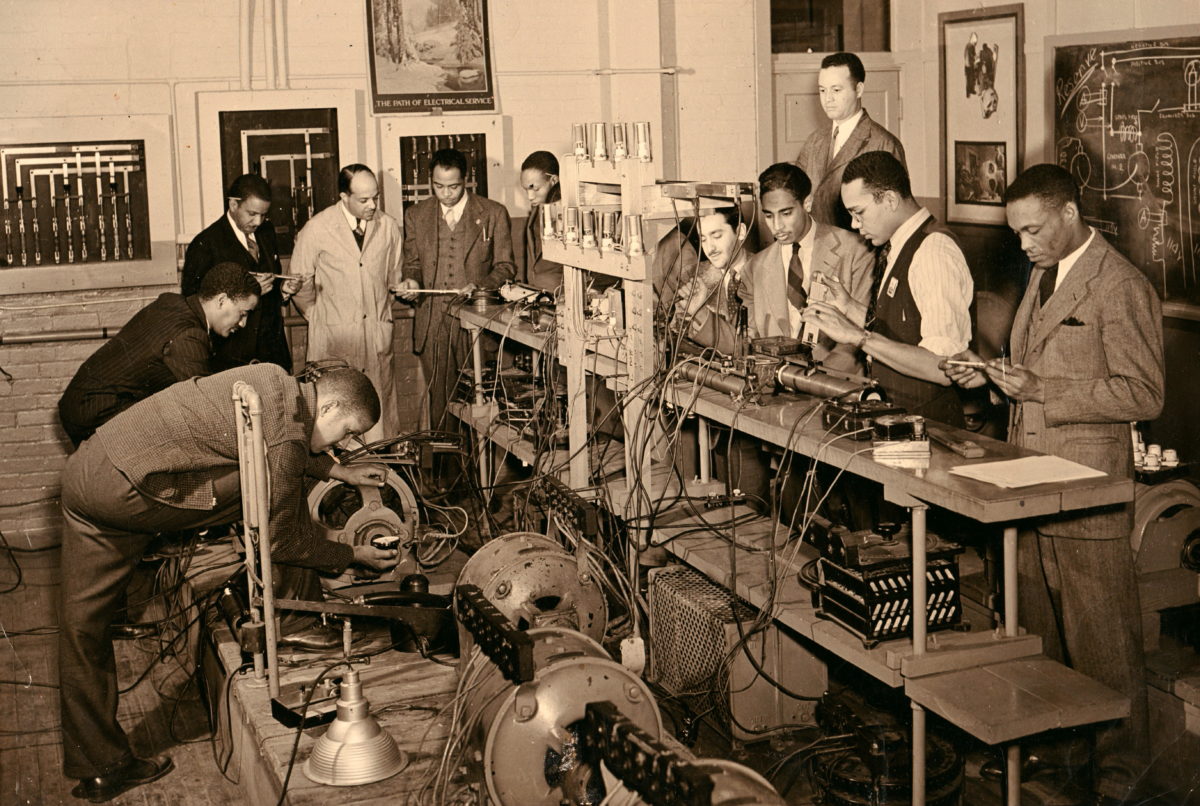
[1] Logan, Rayford W. “Howard University, the First Hundred Years, 1867-1967,” p. 471
[2] Purnell, Bruce. Facebook post, February 22, 2021. https://pt-br.facebook.com/permalink.php?story_fbid=3722714264473945&id=125451407533600 -accessed 3-feb-22
[3] Theodora was one of the organizers of the Florence Nightingale Auxiliary to the Oakland Chapter of the Red Cross which, under her leadership, “did more active work and raised more money during a Red Cross drive than any other colored auxiliary in the United States.” She participated in numerous organizations and fundraisers, including serving on the executive board of “the Old Folks’ home.’” [Beasley, Delilah. “The Negro Trail Blazers.” (1919) p. 300]
[4] California State Archives; Sacramento, California; Board of Medical Examiners Registers of Licensed Physicians, 1901-1939
[5] Soldiers of color, during this time, were called “Immunes” because of the misperception that they were naturally immune to tropical diseases. As an “immune” doctor, William Purnell would have had his hands full tending to solders through multiple outbreaks of yellow fever, typhoid, malaria and dysentery, in addition to injuries from fighting. [NY State Military Museum: Black Americans in the US Military https://museum.dmna.ny.gov/unit-history/conflict/spanish-american-war-1898/black-americans-us-military-american-revolution-korean-war-spanish-american-war-and-philippine-insurgency ][PBS: The Great Fever: Scourge of the Spanish American War https://www.pbs.org/wgbh/americanexperience/features/fever-scourge-spanish-american-war/ ]
[6] Internment form for the San Francisco National Cemetery: Purnell, William W. 2-mar-1935. U.S., National Cemetery 1928–1962 Interment Control Forms, A1 2110-B. Records of the Office of the Quartermaster General, 1774–1985, Record Group 92. The National Archives at College Park, College Park, Maryland.
[7] 1927 Oakland city directory
[8] Beasley, Delilah. “The Negro Trail Blazers” (1919) Chapter XIX, “Doctors and Dentists of the Race in California.” p. 245 and p. 300. (reference edition published in 1987)
[9] The Purnell home was located at 1600 Woolsey Street. [1928 and 1930 Berkeley City Directories, multiple census records]
[10] “Alameda County Track Star Meet at U.C. Saturday: Alameda, Oakland, Technical, and Berkeley to Compete in Prep Classic,” Oakland Tribune, April 29, 1915. P. 14
[11] “Leo[sic] Julian Purnell,”newspaper clipping of unknown origin, 1915
[12] IBID.
[13] Berkeley High School yearbook, 1915. p. 28
[14] Beasley (footnote 8)
[15] “R.O.T.C. Officers and Staff, Spring Semester.” Blue and Gold, 1920. P. 121
[16] Assignments from 1920 Blue & Gold yearbook, full names from “Military Commissions 1919,” Oakland Tribune, 04 Jun 1919, p. 10
[17] The U.S. military conducted some small, controlled experiments with desegregated troops 25 years later, during WWII, but it was considered “unnecessary” to give Black officers command over desegregated units (p. 159-162) until after the Civil Rights movement, in the 1960s. [MacGregor, Morris J., Jr. “Integration of the Armed Forces 1940-1965.” Center of Military History, United States Army, Washington, D. C., 2001. https://history.army.mil/html/books/050/50-1-1/cmhPub_50-1-1.pdf -accessed 10-feb-22]
[18] Beasley (footnote 8)
[19] The Big “C” Society was established at UC Berkeley in 1908 to recognize undergraduate athletes who have earned varsity letters while representing the university in intercollegiate sports. Presumably the “C” stands for “Cal.” [1920 Blue & Gold yearbook, p. 314] [Website: The Big C Society: About https://bigcsociety.org/about -accessed 02-feb-2022 ]
[20] He was listed as a second year “Mec” student in the 1917-18 UC Register, p. 149
[21] 1918-19 UC Register p. 148
[22] His MIT yearbook entry [see next footnote] says that he “prepared at the University of California” for his B.S. in EE.
[23] 1922 Technique (MIT yearbook), p. 95
[24] Purnell’s thesis was co-authored by I.D. Marshall and J. B. Mattson. [“MIT Graduation Exercises, Class of 1921”, p. 43]
[25] MIT Black History: Lee J. Purnell, 1921. https://www.blackhistory.mit.edu/archive/lee-j-purnell-1921 -accessed 14-dec-21
[26] 725 Market Street. 1924, Oakland city directory, p. 1546 & p. 1528
[27] UC Register 1928-29 vol. 1 p. 60
[28] A newspaper description of some of the participants of a Mardi Gras Ball in Oakland concluded with: “…but Miss Corinne Lenear as the Blue Moon was the hit of the evening, decidedly.” [“Mardi Gras Ball at Oakland Auditorium: a Beautiful Affair,” The Western Outlook, San Francisco and Oakland, vol. XXXV, No. 20, Feb. 18, 1928.] She was listed as a member of the Phyliss Wheatley Club of Oakland in 1933 [Beasley, Delilah L. “Negro Women Hear Speakers,” Oakland Tribune 15-sep-1933, p. 14 B]
[28A] Oakland city directories 1917-1922, 1940 Oakland census, Alameda, California; Roll: m-t0627-00445; Page: 1A; Enumeration District: 61-22
[29] Year: 1930; Census Place: Oakland, Alameda, California; Page: 19A; Enumeration District: 0043; FHL microfilm: 2339837
[30] 1930; Census Place: Berkeley, Alameda, California; Page: 6A; Enumeration District: 0276; FHL microfilm: 2339845
[31] “Physician Dies in Berkeley,” California Eagle, 18-jan-1935, p.1, Los Angeles
[32] ”We Are Alcorn” https://www.alcorn.edu/discover-alcorn – accessed 02-feb-22
[33] Marriage applications, 1938. County Marriage Records, 1865-1972 . Arizona History and Archives Division, Phoenix, Arizona U.S.,
[34] Civilian Conservation Corps in California State Parks (Calif. Dept of Parks & Rec): https://www.parks.ca.gov/?page_id=24877 -accessed 30-jan-2021
[34A] Gower, Calvin W. “The Struggle of Blacks for Leadership Positions in the Civilian Conservation Corps: 1933-1942,” The Journal of Negro History, Vol. 61, No. 2, April 1976 P. 128
[34B] Salmond, John A. “The Civilian Conservation Corps and the Negro,” Journal of American History, Vol. 52, Issue 1, June 1965. P. 75 and 88
[34C] Halterman, Justin. “Virginia Center for Digital History: CCC History,” (2007) http://www2.vcdh.virginia.edu/hootowl/CCC%20Historyfinal.htm -accessed 20-feb-2022
[35] Marriage applications, 1938. County Marriage Records, 1865-1972 . Arizona History and Archives Division, Phoenix, Arizona U.S.
[36] Wisconsin Historical Society: Milwaukee’s Trailblazer for Black Voting Rights. https://wisconsinhistory.org/Records/Article/CS16501 -accessed 7-feb-2022
[37] Year: 1940; Census Place: Berkeley, Alameda, California; Roll: m-t0627-00187; Page: 7A; Enumeration District: 1-90
[38] Howard: Our History https://cea.howard.edu/about-us/our-history – accessed 15-jan-2022
[39] “History of The School of Engineering and Architecture,” The Bison (Howard University yearbook), 1952 https://dh.howard.edu/cgi/viewcontent.cgi?article=1120&context=bison_yearbooks accessed 18-jan-2022
[40] Wikipedia: William Whipper https://en.wikipedia.org/wiki/William_Whipper – accessed 20-jan-2022
[41] “Stag Line,” Jett magazine, 19-nov-1953. p. 42. Some sources list her surname as Smith.
[42] “Lee Purnell, 86, Ex-Professor, Dies,” Washington Post, 30-apr-1983 https://www.washingtonpost.com/archive/local/1983/04/30/lee-purnell-86-ex-professor-dies/0f4f1621-9e0e-46b4-9cb0-e7a0f73fadb5/ accessed 01/17/22
[43] MIT Black History [footnote 25]
[44] Washington Post 1983 [footnote 42]
[45] Ebony magazine, oct. 1962, “seafarers yacht club” p. 25
[46] Washington Post 1983 [footnote 42]